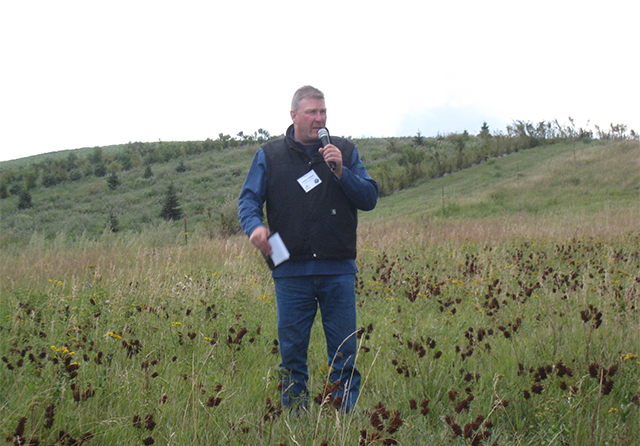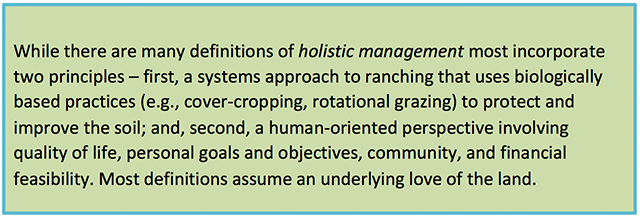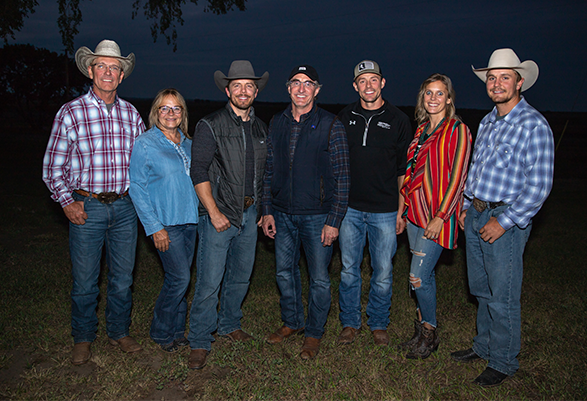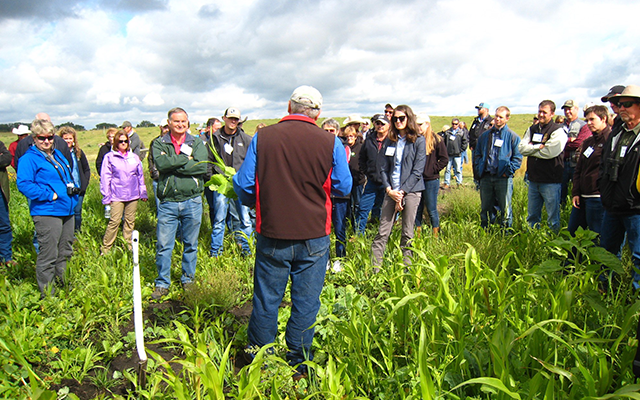The North Dakota Grasslands Policy Tour and Workshop on August 28 and 29, 2018 drew diverse participants from across the state and country such as ranchers, farmers, agency personnel, NGO staff and legislators, including North Dakota governor Doug Burgum. Two ranches in the Missouri Coteau of central North Dakota were part of the tour on August 28 – Oswald Ranch in Wing and Black Leg Ranch near MacKenzie. The following day a policy workshop was held. A panel of producers, agricultural leaders, conservation leaders and policy makers convened at ND Game and Fish headquarters in Bismarck to discuss present and potential policies pertaining to soil health, grasslands and agriculture and to answer questions. Read more about the panel discussion and workshop here.
The main objective of the tour, which was organized by the ND Grazing Lands Coalition and the Prairie Pothole Joint Venture, was to showcase ranching and farming operations that focus on soil health and successfully integrate grassland conservation, annual cropping and wildlife conservation into their business models. Soil health was a unifying theme because it improves grasslands and enriches croplands benefiting wildlife, cattle, agriculture and the North Dakota economy as a whole. Some attendees believed that “the cow is a tool to monetize the grass, which is dependent on the soil,” and others that cost reduction on ranch and farm operations, soil health, quality of life and wildlife conservation come together in the form of grassland conservation. Others saw opportunity for agricultural and ranch production and conservation to be mentioned in the same breath as beneficial to soil health and the North Dakota economy. All viewpoints were welcome.

The tour’s initial stops were at Oswald Ranch West and East (the “home ranch”), respectively, near Wing in northeastern Burleigh County, where participants learned about practices that increase profitability while improving the land and about owner Darrell Oswald, Jr.’s path to his current conservation-oriented operation. Oswald, a fourth generation rancher and farmer, spoke passionately about how replacing “management” with “inputs” has been a win-win situation for him.
In 2006, he and his father began the conversion of the ranch from conventional to holistic because they thought things could be better – the grasslands more productive and drought resilient and their workloads lighter.
Oswald admitted that his is not a perfect system and it takes time to build soil health. However, he was proud that with his current production model they leave more grass than they used to remove. And, over time it has built resiliency into the system, allowing the grasslands to flourish even during drought. During the drought of 2017, Oswald’s octogenarian father, who has experienced his share of dry seasons, looked over the land and commented that it didn’t look like the ranch was in a drought since there was grass on the land.
Oswald Ranch East provided a great example of rotational grazing, which allows for rest and recovery of the soil and desirable plants, as well as the option of “grazing hard” to reduce undesirable species. Other techniques Oswald uses on the ranch are cover cropping, which prevents erosion and reduces organic matter in the soil; no-till agriculture to reduce erosion and soil compaction, increase soil moisture and encourage natural soil microorganisms and a healthy soil ecology; and winter grazing as a way of reducing transportation effort and bolstering organic matter. “Why,” Oswald asked rhetorically, “put the effort into harvesting grass from a field and taking it to cattle in a barn, then, removing the manure and bringing it back to the field, when you can graze cattle on the land in winter?”
Oswald was pleased to relate that the practices have regenerated the soil – the planting of a variety of perennials or cover crops led to a recovery of organic matter present in the soil back to 6% – a very healthy percentage since every percent of organic matter can hold a half inch of moisture.
At the lunch stop, in a verdant riparian area on Black Leg Ranch near MacKenzie, owner Jerry Doan told the group his story. He is passionate about North Dakota, wildlife, beef and his family. His passion led him diversify his operations and to practice holistic management. He recently joined the Audubon Conservation Ranching Program, a new initiative to protect habitat for grassland birds by providing technical assistance to ranchers and marketing beef raised on ranches that practice conservation techniques, such as rotational grazing, to benefit grassland birds. Lucy Love, range technician for Audubon Dakota, was introduced by her organization’s executive director, Marshall Johnson, and spoke about grassland bird surveys she had conducted on the ranch that demonstrated the importance of the area to particular species.
Subsequent stops allowed Doan to show tour participants examples as he discussed his use of rotational grazing, winter grazing, no-till cropping, cover crops, and agricultural tourism.
Both Doan and Oswald described the state, federal and NGO programs they’ve utilized for technical and financial assistance and that are available to other interested farmers and ranchers. These included:
- Grassland Reserve Program, now replaced by the Agricultural Conservation Easement Program (administered by NRCS)
- Conservation Reserve Program (administered by FSA)
- Conservation Stewardship Program (administered by NRCS)
- Environmental Quality Incentives Program (administered by NRCS)
- Wildlife Habitat Improvement Program (repealed, but existing agreements still supported)
- Private Lands Open to Sportsmen (administered by ND Game & Fish)
- Partners for Fish and Wildlife Program (administered by USFWS)
- Audubon Conservation Ranching Program
In the evening, the tour group was treated to a delicious ranch dinner in the Copper Jewell Barn, a spacious facility often used for wedding receptions, followed by a presentation about the diversified business plan of the ranch, which included Rolling Plains Adventures, a microbrewery, and buffalo jerky. Governor Doug Burgum shared his thoughts on the recent local and national achievements received by the Black Leg Ranch and what they mean for agriculture, conservation, recreation and tourism in North Dakota and how conservation and agriculture fit into his Main Street Initiative.


